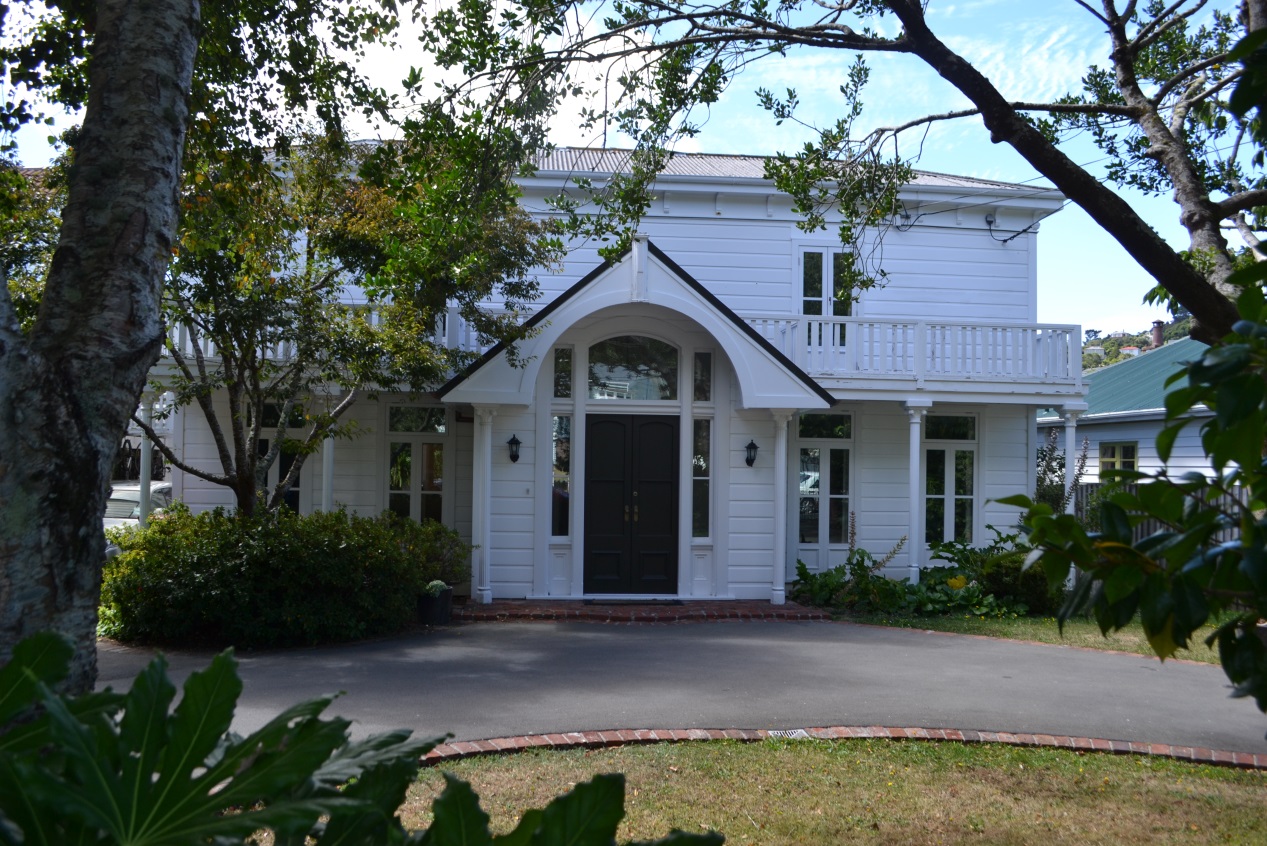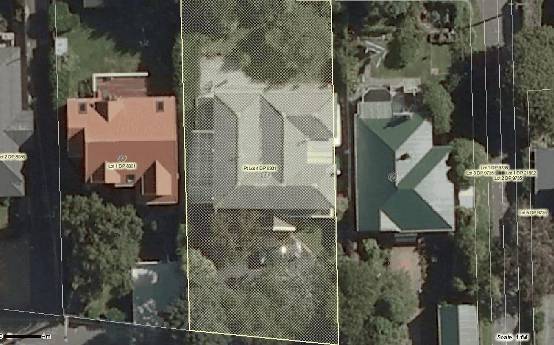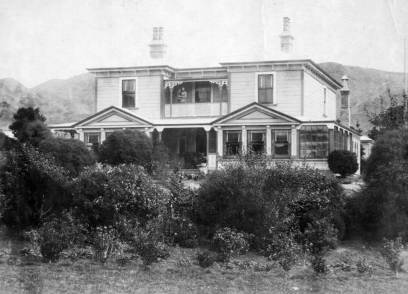Chesney Wold
-
Constructed
c.1866
-
-
Architect(s)
-
Builder(s)
Stephen Lancaster
-
The house has some architectural interest, not for its design features, but for the long history of change that has seen it transformed it in major ways. Its complex physical history makes it an exemplar of the adaptability of timber buildings and the ability to respond to changing needs.
This house has historical value for its association with its original owner Stephen Lancaster, a prominent early Wellingtonian, and with the Beauchamp family and Katherine Mansfield. It is also historically important for its age, as it is among the city’s older houses.
Chesney Wold has been significantly altered from the time of its original construction, and since the time that Katherine Mansfield’s stories detail. It is representative of the adaptability of timber buildings and the ability to respond to changing needs, but careful examination is needed to determine what, if any, original fabric remains.
-
Downloadable(s)
-
close
History
-
This house, known as Chesney Wold, although much changed physically is a significant historic house located in Karori, Wellington. It is best known for its associations with Katherine Mansfield, one of New Zealand’s most prominent authors. The house and the suburb of Karori feature as the setting for three of her stories, guaranteeing the house a lasting fame.
The house was built in 1866 by Stephen Lancaster who later went on to become the first mayor of Karori. Lancaster, a farmer, landowner, and builder, rarely lived in the house, establishing a pattern of turnover of occupancy that has characterised the house’s history. Among the earliest tenants were James Fitzgerald, a former superintendant of the Canterbury province, and from 1872 Carey and Ann Brown. The latter ran a private school at Chesney Wold for two years following her husband’s suicide in 1875. The house is also associated with the Beauchamp family and the work of Katherine Mansfield. Harold Beauchamp took the lease on Chesney Wold in 1893, and Katherine Mansfield spent longer at Chesney Wold than any subsequent home. The property appears to have held some significance for Mansfield as it features in some of her best known stories.
The house underwent major changes in 1901 when the verandah was enclosed, the twin gables removed, and the house converted into an Italianate mansion. It was incrementally added to over the next half century, until in 1969, it was converted into four flats and reduced to a square box. By the 1970s the drastic changes to the appearance of the house began to concern people interest in the Mansfield legacy. A partial restoration was undertaken in the mid 1980s. The house was once accompanied by a great deal of land, with many fruit trees and a large garden, but this has now been subdivided for housing.
-
Modifications
close
-
unknown
-
(original plans cannot be accessed)
-
1946
-
372 Karori Road, tool shed (00056:326:B25424)
-
1960
-
372 Karori Road, convert dwelling to 4 flats (00058:140:C6645)
-
1983
-
372 Karori Road, flat additions and alterations (00058:0:C64009)
-
1990
-
372 Karori Road, carport (00059:375:E19872)
-
1998
-
372 Karori Road, verandah addition and internal alterations (00078:1261:41386)
-
-
Occupation History
close
-
unknown
-
Not assessed
-
-
-
close
Architectural Information
-
Building Classification(s)
close
Not assessed
-
Architecture
close
As the house has undergone a number of changes and alterations, it would take a careful examination of Chesney Wold to determine how much of the original or early fabric of the house remains today. Photographic and documentary evidence indicate several major alterations, not just to the main elevations but to the whole layout and the orientation of the house. Its original orientation and main entrance was on the north side, whereas today the main entrance is on the street (east side). The central porch on this side has a gabled roof and arched opening supported on a column on either side. The porch and door opens off a brick lined driveway, which with trees and grass, forms a pleasant setting for the house back from the road. The east façade now has narrow French doors at both ground and first floor levels, the first floor doors opening out onto a verandah.
-
Materials
close
The wall cladding is rusticated weatherboards, with a bracketed cornice forming the finish at roof level; both these elements could be original, as they are shown in early images of this side of the house. The roof is corrugated iron.
-
Setting
close
Chesney Wold is located in Karori, one of Wellington’s earliest suburbs. The porch and door of the house opens off a brick lined driveway, which with trees and grass, forms a pleasant setting for the house back from the road. The house is mostly obscured from the street, meaning that the house has only modest townscape values. There are good views of Karori, the Karori stream, and the encircling hills from the area around the house.
-
Building Classification(s)
close
-
close
Cultural Value
The house has some architectural interest, not for its design features, but for the long history of change that has seen it transformed it in major ways. Its complex physical history makes it an exemplar of the adaptability of timber buildings and the ability to respond to changing needs.
This house has historical value for its association with its original owner Stephen Lancaster, a prominent early Wellingtonian, and with the Beauchamp family and Katherine Mansfield. It is also historically important for its age, as it is among the city’s older houses.
Chesney Wold has been significantly altered from the time of its original construction, and since the time that Katherine Mansfield’s stories detail. It is representative of the adaptability of timber buildings and the ability to respond to changing needs, but careful examination is needed to determine what, if any, original fabric remains.
-
Aesthetic Value
close
-
Architectural
Does the item have architectural or artistic value for characteristics that may include its design, style, era, form, scale, materials, colour, texture, patina of age, quality of space, craftsmanship, smells, and sounds?
The house has some architectural interest, not for its design features, but for the long history of change that has seen it transformed it in major ways. Its complex physical history makes it an exemplar of the adaptability of timber buildings and the ability to respond to changing needs.
-
Townscape
Does the item have townscape value for the part it plays in defining a space or street; providing visual interest; its role as a landmark; or the contribution it makes to the character and sense of place of Wellington?
The house is situated in a pleasant garden setting and it contributes to the character of the surrounding group of suburban houses. It is not particularly prominent in the streetscape, so has only modest townscape values.
-
-
Historic Value
close
-
Association
Is the item associated with an important person, group, or organisation?
This house has historical value for its association with its original owner Stephen Lancaster, a prominent early Wellingtonian, and with the Beauchamp family and Katherine Mansfield. It is also historically important for its age, as it is among the city’s older houses.
-
-
Scientific Value
close
-
Archaeological
Does the item have archaeological value for its ability to provide scientific information about past human activity?
The house was constructed pre 1900 making it an archaeological site under the Historic Places Act. The risk is unknown, but there is a high likelihood of accidental discovery.
-
Technological
Does the item have technological value for its innovative or important construction methods or use of materials?
There could be significant technical value in the materials and methods of construction if it can be determined which (if any) sections are original to the 1866 building.
-
-
Social Value
close
-
Identity Sense of place Continuity
Is the item a focus of community, regional, or national identity? Does the item contribute to sense of place or continuity?
This house contributes to the sense of place and continuity in Karori due to its long standing place on the street and its significant historical associations.
-
Public esteem
Is the item held in high public esteem?
This house is held in high public esteem due to its association with Katherine Mansfield and her writing. The restoration of the house in the 1980s was partially a response to those interested in Mansfield and her legacy becoming concerned with the appearance of the house.
-
-
Level of Cultural Heritage Significance
close
-
Authentic
Does the item have authenticity or integrity because it retains significant fabric from the time of its construction or from later periods when important additions or modifications were carried out?
This house has been through a number of major alterations, but some rusticated weatherboards and the bracketed cornice forming the finish at roof level could be original.
-
Local Regional National International
Is the item important for any of the above characteristics at a local, regional, national, or international level?
Chesney Wold is a locally important building with some nationally important historical associations. It is best known for its association with Katherine Mansfield and as the setting for several of her stories. The alterations and modifications that have occurred have impacted significantly upon its heritage values as it is difficult to determine whether any of the 1866 fabric remains.
-
Representative
Is the item a good example of the class it represents?
Chesney Wold has been significantly altered from the time of its original construction, and since the time that Katherine Mansfield’s stories detail. It is representative of the adaptability of timber buildings and the ability to respond to changing needs, but careful examination is needed to determine what, if any, original fabric remains.
-
-
Local / Regional / National / International Importance
close
Not assessed
-
Aesthetic Value
close
-
close
Site Detail
-
District Plan Number
11/169
-
Legal Description
Lot 4 DP 8301
-
Heritage New Zealand Listed
Not Listed
-
Archaeological Site
Pre 1900 building
-
Current Uses
unknown
-
Former Uses
unknown
-
Has building been funded
No
-
Funding Amount
Not applicable
-
Earthquake Prone Status
Not Earthquake Prone
-
-
close
Additional Information
-
Sources
close
- Kelly, Michael and Chris Cochrane. ‘372 Karori Road – Chesney Wold’. Unpublished heritage assessment, prepared for the Wellington City Council, 2001.
- Chesney Wold, Karori Road, ca 1901. Karori Historical Society :Photographs of Karori. Ref: PAColl-5277-1-11. Alexander Turnbull Library, Wellington, New Zealand.
- 1946 372 Karori Road, tool shed (00056:326:B25424)
- 1960 372 Karori Road, convert dwelling to 4 flats (00058:140:C6645)
- 1983 372 Karori Road, flat additions and alterations (00058:0:C64009)
- 1990 372 Karori Road, carport (00059:375:E19872)
- 1998 372 Karori Road, verandah addition and internal alterations (00078:1261:41386)
-
Technical Documentation
close
Not available
-
Footnotes
close
Not available
-
Sources
close
Last updated: 10/24/2017 11:12:33 PM



